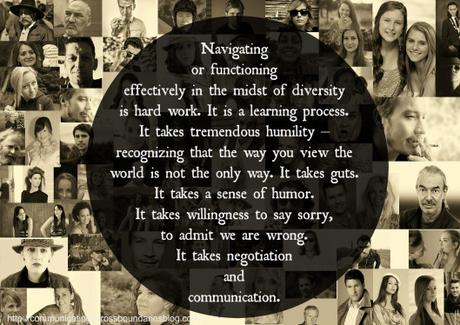
I live in a diverse neighborhood in a diverse area. Every day I ride the subway with people of many different backgrounds and ethnicities. I go to work and sit next to a man from Malawi and have friendships and work with women from Haiti, Jamaica, Costa Rica, Senegal, Portugal, Cameroon, and Roxbury – and that’s just naming a few.
But so what? Just because there is diversity in my life doesn’t mean I know how to navigate diversity. It doesn’t mean I exercise cultural humility in my interactions. It doesn’t mean that I don’t make mistakes and show my prejudice, sometimes well dressed and well hidden, other times more overt.
It’s not enough to recognize, and be sensitive toward, diversity. We need to learn how to navigate diversity.
In the 2012 census, census officials in the United States said that by the end of the decade “no single racial or ethnic group will dominate the majority of children under 18.” By the end of three decades, the same will hold true for the population at large.
More and more, the United States is seeing communities change from predominantly white, to a veritable ‘salad bowl’ of color. A place where people from many ethnic and racial backgrounds live, work, play, and fight together.
I’m tired of hearing about diversity. As long as we just talk diversity, nothing will change. Because diversity just means ‘difference.’
This is what the dictionary says when defining diversity:
- the quality or state of having many different forms, types, ideas, etc.
- the state of having people who are different races or who have different cultures in a group or organization
When it comes to a health care organization, a school, even a church, that definition is singularly unhelpful. Because all it gives you is the what – not the how. It gives you nothing about the good and the hard of a diverse population of people living, working, playing, and fighting together.
I think we need to stop talking ‘diversity’ and start talking about ‘navigating diversity.’ One of the ways to do this is by learning what it is to be culturally competent — learning how to function effectively across cultural differences.
As I think about the many tragedies that have affected the United States in the past few months, I am struck by the fact that no one has been talking about the importance of learning how to function effectively in the midst of difference – whether that difference be racial, socioeconomic, cultural, or physical. And that is just naming a couple of areas where we see diversity in our communities.
We can talk all day long about diversity, but if we don’t have tools on how to navigate this diversity, than the talk is empty and nothing will ever change.
So for a moment, I want to talk about cultural competency. A disclaimer here – when it comes to cultural competence I am most familiar with how this plays out in the world of health care. This is where I see difference and inability to navigate difference played out regularly. So the way I approach this is from that perspective. I want to talk about what it is, why we need it, and some tools for how to move forward in this area. I hope to do this in the next few blog posts so I would love it if you tracked with me.
Cultural competency is a field of study, a series of behavioral changes, and a strategy for working with and serving diverse populations. The term was born in the field of mental health but didn’t make its way into medical literature until the early 1990s. The words and ideas behind cultural competency began to get more recognition in 2002 when the Institute of Medicine published a report (now a book) called Unequal Treatment: Confronting Racial and Ethnic Disparities in Health Care. This report highlighted extensive areas where racial and ethnic minorities receive lower quality health care, even when their income and insurance status were the same. Among several recommendations given at the end of the study was the need for systematic cultural competency trainings.
There are several different definitions for cultural competency.
A colleague and I use prefer this one, partly because it is simple and short:
A learning process that enables individuals and organizations to respect, value — and function effectively in the midst of — cultural difference.
The definition accurately portrays cultural competency as something that is ongoing, something that has to be learned and practiced. Cultural competency is a continuum and needs to be seen in stages.
Why do we need it?
We need cultural competency because there are overwhelming disparities in almost any area we could mention. In health care, everything from access to pain medication to being offered treatment for cancer shows overwhelming differences in quality of care. For example, in one study minority patients were more likely to be under-medicated for pain than white patients (65% vs. 50%), and more likely to have severity of pain underestimated by caregivers. Another study in the area of mental health indicated that 44% of White English speakers to 27.8% of Blacks received treatment after a diagnosis of depression. These disparities are well-documented in the book I cited above.
In an extensive survey conducted by the U.S. Department of Education’s Office for Civil Rights showed that racial disparities are well documented and pervasive in various areas of education. Here are some of the key findings from this survey:*
- Access to preschool. About 40% of public school districts do not offer preschool, and where it is available, it is mostly part-day only. Of the school districts that operate public preschool programs, barely half are available to all students within the district.
- Suspension of preschool children. Black students represent 18% of preschool enrollment but 42% of students suspended once, and 48% of the students suspended more than once.
- Access to advanced courses. Eighty-one percent (81%) of Asian-American high school students and 71% of white high school students attend high schools where the full range of math and science courses are offered (Algebra I, geometry, Algebra II, calculus, biology, chemistry, physics). However, less than half of American Indian and Native-Alaskan high school students have access to the full range of math and science courses in their high school. Black students (57%), Latino students (67%), students with disabilities (63%), and English language learner students (65%) also have less access to the full range of courses.
- Access to college counselors. Nationwide, one in five high schools lacks a school counselor; in Florida and Minnesota, more than two in five students lack access to a school counselor.
- Retention of English learners in high school. English learners make up 5% of high school enrollment but 11% of high school students held back each year.
We need cultural competency in health care because it is one of the ways we can provide quality care. We need cultural competency in education because our schools have students of all colors, backgrounds, and religious beliefs. Cultural competency is one way to serve these diverse students and their families. Learning doesn’t take place in a vacuum and the student’s family and culture are critically important to their education. We need cultural competency in law enforcement because those in the field often encounter the challenges of interpreting and understanding the behavior and attitudes of those who are culturally and linguistically different than they are.
Talking about navigating effectively through difference is far more difficult than talking about being sensitive to, or appreciating difference. Navigating or functioning effectively in the midst of diversity is hard work. It is a learning process. It takes tremendous humility – recognizing that the way you view the world is not the only way. It takes guts. It takes a sense of humor. It takes willingness to say sorry, to admit we are wrong. It takes negotiation and communication.
In the next couple of blog posts I hope to discuss a fraction of how I think cultural competency can help us to work, serve, and form friendships more effectively as well as some tools that increase people’s ability to navigate across cultural differences. In the mean time, what do you think? Do you talk about cultural competency in your area of work? Why or why not?
*http://www.ed.gov/news/press-releases/expansive-survey-americas-public-schools-reveals-troubling-racial-disparities
Photo Credit: http://pixabay.com/en/photo-montage-faces-photo-album-556806/ word art by Marilyn R. Gardner

